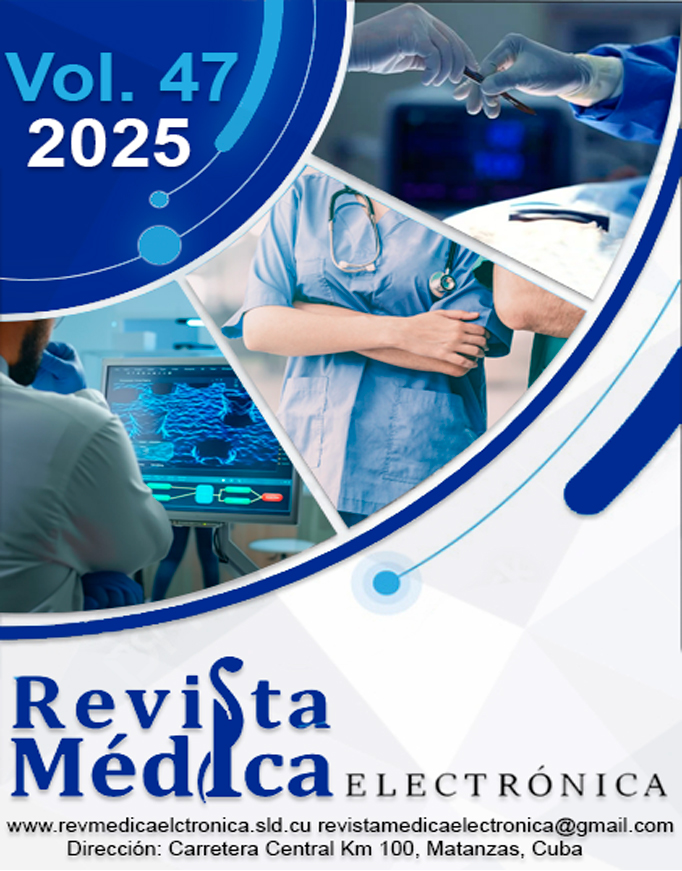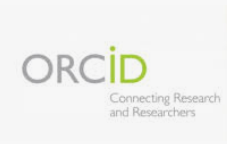Periodontal clinical status of patients with alveolus palatal lip fissure
Keywords:
cleft palate, dental plaque, microbiota, oral health, orthodontics, periodontitisAbstract
Introduction: The alveolus palatal lip fissure is a type of oral-facial malformation that can affect oral health and, consequently, self-esteem.
Objective: To describe the clinical periodontal status of the upper anterior sextant in patients with alveolus palatal lip fissure.
Methods: A descriptive, cross-sectional study was designed to evaluate 60 patients diagnosed with alveolus palatal lip fissure. The following conditions were analyzed through direct clinical observation: periodontal condition (the amount of soft biofilm, gingival bleeding, clinical attachment level, and probing depth), gingival condition (the extent of gingival recession, periodontal phenotype, type of labial frenulum, and amount of keratinized gingiva), and dental condition (missing teeth and tooth mobility).
Results: Thirty-four patients were male (56.7%). The mean age was 18±7 years, and 93.3% had at least one orthodontic treatment. Thirty percent (n=18) presented unilateral right-sided alveolus palatal lip fissure, and 35% bilateral alveolus palatal lip fissure. Patients with unilateral left-sided alveolus palatal lip fissure had poor oral hygiene (23.3%). Many frenulums with gingival insertion were found, mainly in patients with unilateral right fissure (20%). The greatest amount of keratinized gingiva was evident at the level of the upper right lateral incisor (4.12±0.74) and the lowest amount at the level of the upper right canine (3.77±0.44).
Conclusions: The periodontal status of patients with alveolus palatal lip fissure is heterogeneous, with a higher frequency of poor oral hygiene, but with stable gingival conditions, which do not show evidence of progression of inflammatory processes.
Downloads
References
1. Alois CI, Ruotolo RA. An overview of cleft lip and palate. JAAPA. 2020;33(12):17-20. DOI: 10.1097/01.JAA.0000721644.06681.06.
2. Nasreddine G, El Hajj J, Ghassibe-Sabbagh M. Orofacial clefts embryology, classification, epidemiology, and genetics. Mutat Res Rev Mutat Res. 2021;787:108373. DOI: 10.1016/j.mrrev.2021.108373.
3. Salari N, Darvishi N, Heydari M, et al. Global prevalence of cleft palate, cleft lip and cleft palate and lip: A comprehensive systematic review and meta-analysis. J Stomatol Bucal Maxillofac Surg. 2022;123(2):110-20. DOI: 10.1016/j.jormas.2021.05.008.
4. Gonzales Mendoza J, Campos Campos J. Labio paladar fisurado: Una perspectiva global. Diagnóstico. 2020;57(1):21-4. DOI: 10.33734/diagnostico.v57i1.78.
5. Khatri A, Khatri M, Bansal M, et al. Periodontal and microbiological evaluation in cleft lip/palate patients undergoing orthodontic treatment: A cross-sectional study. J Periodontol. 2025;96(1):44-54. DOI: 10.1002/JPER.24-0085.
6. De Oliveira Júnior AG, Montagna E, Zaia V, et al. Bucal health-related quality of life in patients aged 8 to 19 years with cleft lip and palate: a systematic review and meta-analysis. BMC Bucal Health. 2023;23(1):670. DOI: 10.1186/s12903-023-03382-4.
7. Nascimento VdC, Martins MME, Vilella BS, et al. Influence of clinical and demographic factors on the bucal health-related quality of life of patients with cleft lip and palate undergoing orthodontic treatment: a systematic review and meta-analysis. Eur J Orthod. 2022;44(3):268-78. DOI: 10.1093/ejo/cjab074.
8. Cardinal L, da Rosa Zimermann G, Mendes FM, et al. Dehiscence and buccal bone thickness after rapid maxillary expansion in young patients with unilateral cleft lip and palate. Am J Orthod Dentofacial Orthop. 2022;162(1):16-23. DOI: 10.1016/j.ajodo.2021.01.038
9. Salvi GE, Bragger U, Lang NP. Periodontal attachment loss over 14 years in cleft lip, alveolus and palate (CLAP, CL, CP) subjects not enrolled in a supportive periodontal therapy program. J Clin Periodontol. 2003;30(9):840-5. DOI: 10.1034/j.1600-051x.2003.00390.x.
10. Ercan E, Celikoglu M, Buyuk SK, et al. Assessment of the alveolar bone support of patients with unilateral cleft lip and palate: a cone-beam computed tomography study. Angle Orthod. 2015;85(6):1003-8. DOI: 10.2319/092614-691.1.
11. Plakwicz P, Wyrębek B, Górska R, et al. Periodontal Indices and Status in 34 Growing Patients with Unilateral Cleft Lip and Palate: A Split-Mouth Study. Int J Periodontics Restorative Dent. 2017;37(6):e344-53. DOI: 10.11607/prd.3461.
12. Wyrebek B, Cudzilo D, Plakwicz P. Evaluation of periodontal tissues in growing patients with bilateral cleft lip and palate. A pilot study. Dev period Med. 2017;21(2):154-61. DOI: 10.34763/devperiodmed.20172102.154161.
13. Celikoglu M, Buyuk SK, Hatipoglu M, et al. Evaluation of dehiscence and fenestration in adolescents affected by bilateral cleft lip and palate using cone-beam computed tomography. Am J Orthod Dentofac Orthop. 2017;152(4):458-64. DOI: 10.1016/j.ajodo.2017.01.024.
14. Laster L, Laudenbach KW, Stoller NH. An Evaluation of Clinical Tooth Mobility Measurements. J Periodontol. 1975;46(10):603-7. DOI: 10.1902/jop.1975.46.10.603.
15. Niemczyk W, Niemczyk S, Prokurat M, et al. Etiology of gingival recession - a literature review. Wiad Lek. 2024;77(5):1080-5. DOI: 10.36740/WLek202405131.
16. Abdelhafez RS, Mustafa NM. Determining the periodontal phenotype-Probe transparency versus actual: A diagnostic study. J Esthet Restor Dent. 2023;35(7):1001-7. DOI: 10.1111/jerd.13032.
17. Mirko P, Miroslav S, Lubor M. Significance of the Labial Frenum Attachment in Periodontal Disease in Man. Part II. An Attempt to Determine the Resistance of Periodontium. J Periodontol. 1974;45(12):895-7. DOI: 10.1902/jop.1974.45.12.895.
18. Silva Cordeiro AC, Olegário da Costa IC, Rampazzo Bresolin C, et al. Calidad de vida relacionada con la salud bucal, características socioeconómicas y de comportamiento de los pacientes fisurados menores de 7 años. Rev Odontoped Latin. 2021;8(1). DOI: 10.47990/alop.v8i1.143.
19. Prieto-Gómez R, Carreño A, Contreras A, et al. Fisura Labio Palatina. Revisión de la Literatura. Int J Morphol. 2022;40(6):1460-5. DOI: 10.4067/S0717-95022022000601460.
20. Pardo A, Vanti V, Lonardi F, et al. Oral health in patients with cleft lip and palate: a systematic literature review and meta-analysis of periodontal and dental disease and oral microbiota (part 1). BMC Bucal Health. 2025;25(1):154. DOI: 10.1186/s12903-025-05494-5.
21. Marzouk T, Youssef M, Tsigarida A, et al. Association between bucal clefts and periodontal clinical measures: A meta-analysis. Int J Paediatr Dent. 2022;32(4):558-75. DOI: 10.1111/ipd.12934.
22. De Almeida A, Esper L, Pegoraro TA, et al. Gingival recession in individuals with cleft lip and palate: Prevalence and severity. Cleft Palate Craniofac J. 2012;49(1):92-5. DOI: 10.1597/10-052.
23. Gaggl A, Schultes G, Kärcher H, et al. Periodontal Disease in Patients With cleft Palate and Patients With Unilateral and Bilateral Clefts of Lip, Palate, and Alveolus. J Periodontol. 1999;70(2):171-8. DOI: 10.1902/jop.1999.70.2.171.
Downloads
Published
How to Cite
Issue
Section
License
Copyright (c) 2025 Juan Sánchez-Verde, Sixto Grados-Pomarino, Yuri Castro-Rodríguez

This work is licensed under a Creative Commons Attribution-NonCommercial 4.0 International License.
All content published in this journal is Open Access, distributed under the terms of the CC BY-NC 4.0 License.
It allows:
- Copy and redistribute published material in any medium or format.
- Adapt the content.
This will be done under the following terms:
- Attribute the authors' credits and indicate whether changes were made, in which case it must be in a reasonable way.
- Non-commercial use.
- Recognize the journal where it is published.
The copyrights of each article are maintained, without restrictions.






